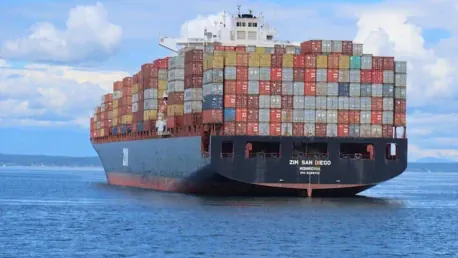The shipping industry is currently facing heightened challenges, significantly influenced by a surge in fires aboard container vessels. These rising incidents are not only jeopardizing maritime safety but are also resulting in substantial financial ramifications for shipping companies and insurers alike. One of the most recent incidents involved an explosion on the Yang Ming-owned container ship YM Mobility at the Port of Beilun in Ningbo, China, caused by refrigerated organic peroxides. Fortunately, no casualties were reported; however, this event is part of a troubling trend of fires that has been plaguing the industry, as seen recently with other ships operated by companies like Maersk and MSC. The risks associated with these fires are multiplying, highlighting an urgent need for better safety measures and risk management strategies in the maritime sector.
Increasing Frequency of Container Ship Fires
Recent incidents highlight a worrying trend in the maritime sector. For instance, an explosion on the Yang Ming-owned container ship YM Mobility at the Port of Beilun in Ningbo, China, caused by refrigerated organic peroxides, underscores the prevalent risk. Although no casualties were reported, the event is part of a series of similar fires plaguing the industry, including those experienced by Maersk and MSC. These fires have become a central concern for the maritime industry. Container ships are particularly vulnerable due to the nature of the cargo they carry, which often includes hazardous materials. The misdeclaration of such materials exacerbates the danger, leading to catastrophic fires that can spread rapidly.
The upward trend in container ship fires not only threatens the physical safety of crew members but also has far-reaching economic consequences for shipping companies. Freight transportation’s reliance on these enormous vessels makes them vital to global trade, yet this dependence also amplifies the fallout when fires occur. When a disaster strikes, the damage to cargo and the vessel itself runs into millions of dollars, and the ripple effects can disrupt supply chains, causing delays that affect industries worldwide. Therefore, understanding and mitigating the risk of fires on container ships is becoming an increasingly urgent priority for all stakeholders involved in maritime logistics.
Consequences for the Insurance Sector
The insurance sector is feeling the strain of these increased risks. Fires aboard container ships lead to significant losses, impacting both cargo and hull insurance. Insurers are responding by raising premiums to counterbalance the increased risk, putting additional financial pressure on shipping firms. Marine underwriters are reassessing risk profiles more conservatively, resulting in higher premiums across the board. This trend of escalating claims and premiums signifies a troubling outlook for the industry. Insurers are adopting more cautious approaches, demanding better safety measures and accurate declarations from shipping companies to mitigate potential losses. The financial burden imposed by these fires necessitates that shipping companies explore more robust safety protocols to reduce the occurrence of such incidents.
The increased risk and subsequent rise in insurance premiums are causing shipping companies to reconsider their budgeting and operational strategies. These developments are forcing shipping companies to allocate more resources toward risk management and safety measures, including better training for crew members and investment in fire detection and suppression systems. Ultimately, these costs trickle down the supply chain, potentially resulting in higher costs for consumers. The interplay between elevated risks and insurance premiums continues to be a pressing concern that requires a multi-faceted approach to ensure that the maritime industry can sustainably manage such significant challenges.
Fire Safety and Prevention Challenges
The evolving nature of container ship design also presents considerable challenges in terms of fire safety. Modern container vessels now carry significantly more cargo than in previous decades, up to 1500% more, necessitating enhanced firefighting capabilities. However, current safety measures often fall short of what is required to tackle fires on such a massive scale. Experts argue that investment in better firefighting technology is critical. Improved training for crews and the adoption of advanced detection systems are essential steps toward mitigating fire risks. The continued growth in the size and capacity of container ships makes it imperative for the industry to develop fire safety measures that keep pace with these advancements.
The complexity of modern container ships also complicates fire safety efforts. Larger vessels require more intricate coordination and readiness to effectively manage emergencies, and current onboard firefighting equipment may not adequately address these larger-scale risks. Comprehensive fire safety strategies must include advanced technological solutions like automated fire suppression systems, enhanced heat detection units, and more rigorous crew training programs. Additionally, better regulations for the accurate declaration of hazardous materials would greatly mitigate the risk of fires, underscoring the need for a collaborative approach between shipping companies, insurers, and regulatory bodies to create a safer operating environment.
Regulatory Responses and Future Implications
The International Maritime Organization (IMO) and other regulatory bodies are likely to introduce more stringent regulations concerning fire safety and cargo declarations. These forthcoming regulations aim to address the root causes of the fires, ensuring stricter compliance and better safety standards. Shipping companies may face new requirements for fire suppression systems and mandatory training programs for handling hazardous materials. Enhanced regulations will likely lead to increased operational costs for shipping companies. These costs, combined with higher insurance premiums, underscore the need for prudent financial and logistical planning. As regulators push for better safety standards, shipping firms must balance compliance with maintaining operational efficiency.
The anticipated regulatory changes are poised to reshape the shipping industry’s landscape significantly. While these new rules aim to improve safety and reduce the risk of catastrophic fires, they also come with financial implications. Companies may need to invest in new technologies and training programs to comply with these regulations, which can be particularly challenging for smaller operators with limited budgets. Moreover, the increased scrutiny and potential penalties for non-compliance will drive shipping firms to adopt more stringent operational protocols. The overall impact of these regulatory shifts underscores the importance of staying ahead of compliance requirements to ensure not only safety but also the financial viability and operational efficiency of shipping enterprises.
Logistical and Financial Challenges
Fires on container vessels not only pose immediate safety risks but also lead to complex logistical challenges. General average declarations, an ancient maritime practice of sharing costs among stakeholders for cargo damage or loss, often delay cargo release. These delays can be particularly detrimental for businesses relying on seasonal goods, which may miss critical market windows. The financial impact extends beyond immediate damage control and salvage operations. Prolonged delays and disruptions can lead to missed deadlines, contractual penalties, and strained relationships with clients. Effective contingency planning becomes crucial to navigate these challenges, ensuring timely delivery and minimizing disruptions.
The financial repercussions of container ship fires extend into various facets of maritime operations. From increased insurance premiums to potential legal claims, the costs can quickly escalate, affecting the bottom line for shipping companies. Moreover, the reputation of a shipping company can suffer considerably following a high-profile disaster, leading to loss of business and client trust. Consequently, investing in robust contingency planning and maintaining high operational standards are critical for mitigating these risks. Ensuring that backup plans are in place and that all stakeholders are prepared to respond efficiently can significantly reduce the financial and logistical impact of such devastating incidents.
Broader Maritime Risks
The insurance sector is grappling with elevated risks, particularly with fires aboard container ships, which lead to significant cargo and hull losses. Insurers are responding by hiking premiums to counteract the heightened risk, adding financial pressure on shipping firms. Consequently, marine underwriters are adopting conservative risk profiles, resulting in universally higher premiums. This trend portends a troubling outlook as insurers demand better safety protocols and precise declarations from shipping companies to mitigate potential losses. The financial toll of these fires necessitates that shipping companies employ more stringent safety protocols to reduce such incidents.
Increased risk and subsequent insurance premium hikes force shipping companies to rethink their budgeting and operational approaches. These developments require them to allocate more resources to risk management and safety measures, including comprehensive crew training and investment in advanced fire detection and suppression systems. Ultimately, these costs may pass down the supply chain, potentially leading to higher prices for consumers. The dynamic between rising risks and insurance premiums remains a critical issue, necessitating a multi-faceted strategy to ensure the maritime industry can sustainably address these substantial challenges.









